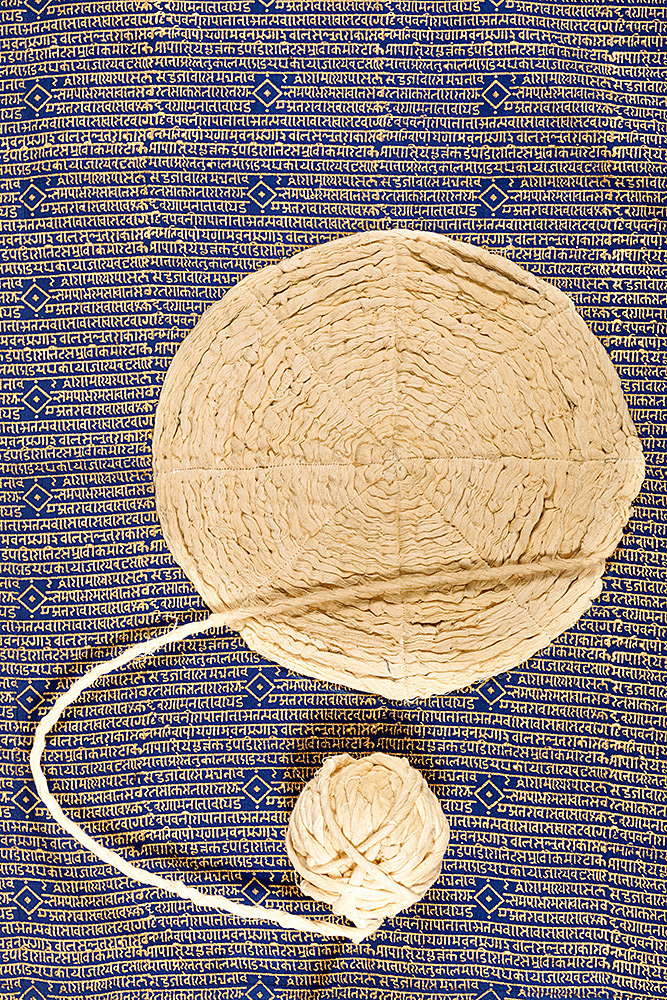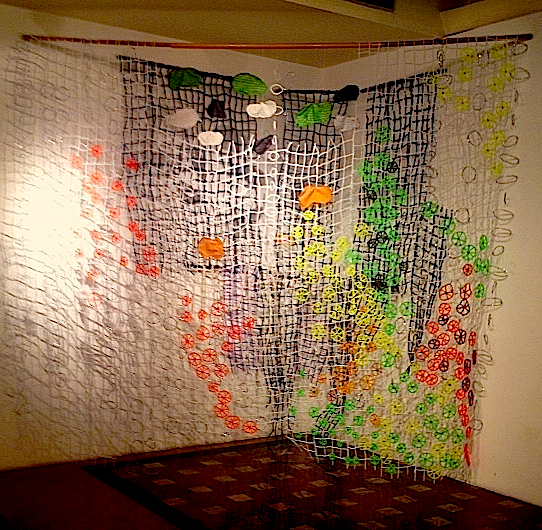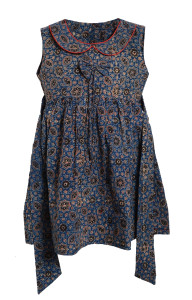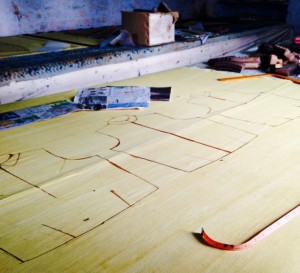Shelly Jyoti, SALT: THE GREAT MARCH Re-Contextualizing Ajrakh Textile Traditions on khadi in Contemporary Art and Craft
Site Specific Installation
THE MARCH “INTEGRATING KHADI 2013
50 pieces of constructed sails from khadi fabric
Cotton threads
2013-14-15
If we have the ‘khadi spirit’ in us, we would surround ourselves with simplicity in every walk of life. The ‘khadi spirit’ means illimitable patience. For those who know anything about the production of khadi know how patiently the spinners and the weavers have to toil at their trade, and even so must we have patience while we are spinning ‘the thread of Swaraj’. The ‘khadi spirit’ also means an equally illimitable faith. Even as the spinner toiling away at the yarn, spins by itself small enough, put in the aggregate, would be enough to clothe every human being in India, so must we have illimitable faith in truth and non-violence ultimately conquering every obstacle in our way.The ‘khadi spirit’ means fellow-feeling with every human being on earth. It means a complete renunciation of everything that is likely to harm our fellow creatures, and if we but cultivate that spirit amongst the millions of our countrymen, what a land this India of ours would be! And the more I move about the country and the more I see the things for myself, the richer, the stronger is my faith growing in the capacity of the spinning wheel.(Young India, 22- 9-1927)
The installation represents the Gandhian thought or developing khadi across the villages for the economic independence of the then predominantly agrarian society. It was expected to support the farmers who used to be debt-ridden and to make them self-reliant. This concept is relevant even today from a nationalistic perspective. Now modern industries and designers stepped in to take khadi upwards on the higher scale of acceptability .The expansion of rural industry in khadi production has not happened due to large scale industrialization in the textile sector with large scale automation and synthetic fibres.
I am exploring that if o ne could wear the khadi, can the commitment to action of wearing by all bring the nationalistic feeling in 21st century.Though I know that forcing people to wear a particular kind of fabric is not politically correct in today’s world, seen from the perspective of the Gandhian ideals of Sarvodaya and Swadharma, preferring khadi fabric for daily use could be one way to counter the homogenizing culture of globalization. While the use of Khadi would help to redeem a dying economic sector from its untimely device, the choice could also instil some kind of national pride, which is devoid of nationalistic rhetoric and aggressive posturing. The incorporation of Sanskrit calligraphy in the installation should be seen in this context of recognizing the national pride than connecting it with certain dominant ideologies prone to contestation. The installation, in its formal and technical organization tries to emulate the brisk walking of Gandhiji and it also implies the kinetic feel that I add to many of my installations.
Shelly Jyoti, SALT: THE GREAT MARCH Re-Contextualizing Ajrakh Textile Traditions on khadi in Contemporary Art and Craft
Site Specific Installation
The Threads of Swaraj ,50000 threads from 50 attis spun in Dandi Gujarat
Aluminum hose pipe
2013

Background: Gandhiji called on everyone engaged in the struggle for independence from British rule to spin for at least a half hour each day. He credited spinning with spiritual cleansing and saw it as a unifying ritual, one that could also provide needed sustenance to the poor in India. He chooses this particular activity of the production of khadi by spinning as an activity that would enable people to participate in the nationalist movement. Spinning brought politics into the domestic sphere and thereby included women too in the political process of Swaraj. Spinning, in practice and as a visual icon, became the center of the nationalist movement. One could wear khadi, but the commitment to the action was truly metamorphosed in the spinning idea.
I am inspired by the process of spinning as a meditative process to perform one’s pious duty towards the nation and for the general up-liftment of people through non-violent but affirmative action. Hence to me, it carries an important symbolical and metaphorical meaning. This installation is dedicated to the veteran freedom fighters like Acharya Dhirubhai and Gosai Bhai Patel who despite their advancing age and failing health, still devotedly pursue Gandhian principles. I met them personally on my visit to Dandi (July2013) to get more inspired on my project. .I have collected these threads from the khadi cooperative located at Panchkaka ni vadi where the weavers in Dandi submit their produce. I have used 50,000 threads from 50 attis produced by these weavers.
Shelly Jyoti, SALT: THE GREAT MARCH Re-Contextualizing Ajrakh Textile Traditions on khadi in Contemporary Art and Craft
Site Specific Installation
Spinning Wheel: The Charkha
90 Sculptural textile circles,108×108 “ (8 inches diameter each)
Traditional Ajrakh prints
2013
Background: “The revival of hand-spinning and hand-weaving would make the largest contribution to the economic and the moral regeneration of India. The millions must have a simple industry to supplement agriculture. Spinning was the cottage industry years ago, and if the millions are to be saved from starvation, they must be enabled to introduce spinning in their homes, and every village must repossess its own weaver.”‘The message of the spinning wheel is much wider than its circumference. Its message is one of simplicity, service of mankind, living so as not to hurt others, creating an indissoluble bond between the rich and the poor, capital and labor, the prince and the peasant. That larger message is naturally for all.” Harijan, 19th Feb, 1938,p11
The installation Spinning Wheel: The Charkha consists of 90 chakras or wheels of Azrakh textile prints. It is about my hope for the empowerment of people living in rural India. As every household during pre-independence India was spinning and weaving while envisioning freedom from British rule, I feel that spinning, weaving and wearing khadi in present times has the potential to bring about significant social change. If people living in urban areas started wearing and buying khadi, the demand for khadi would create job opportunities for rural youth and also in turn by re-educate and reinforce ideas of peace and nonviolence that we have sadly lost.
As well as symbolizing the potential empowerment of rural communities through the weaving of khadi, in this installation I explore the formal qualities of different colored sculptural textile circles combined into one large circle, which creates sense of constant movement ie the change
Shelly Jyoti, SALT: THE GREAT MARCH Re-Contextualizing Ajrakh Textile Traditions on khadi in Contemporary Art and Craft
Site Specific Installation
Gallery installations of Azrakh samplers:
55 sculptural fabric swatches of azrakh prints
2014

Description These samples are array of designs and patterns from my collection. I use these sample to create my artworks. Each sample design block has a name in local language eg kankharak, Rialgad, gurda kaleji, bodyrial, Zimardi, Beedi boota, Asopalav, Nipuri, champakali, Pancho,Keribel, Mijidbel.
The samples are created in collaboration with Ajrakh artisans to document the blocks and laborious printing /dyeing technique.
The art is said to have originated in the 16th century CE, on this side of the Indus River, where the Thar Desert spreads across the regions in Gujarat and Rajasthan bordering Pakistan. The erstwhile ruler of Kutch Rao Bharmalji – I (1586–1631), invited the cloth-printing Khatri artisans from Sindh and gave them permission to settle and earn their livelihoods anywhere in Kutch. They were given land by the state as well spared any taxation on their produce. Over time, the villages of Dhamadka and Khavda in Kutch became the primary centres of the craft, followed by Barmer in Rajasthan, which too became recognised as an important centre. Most of the artisans of Kutch and Barmer believe that their ancestors were from Sindh, and even now many of their relatives live in the Sindh region.From a technical perspective, Ajrakh is a very demanding and laborious form of cloth-printing and resist dyeing. To get the desired result from the resist dyeing, lime is used as an adhesive, which is an indicator of the special skills of the artisan. Ajrakh designs, in terms of variety and arrangments, are limited. However, the Ajrakh cloths, evenly printed on both sides, display the pinnacle of achievement in printing.One of Ajrakh’s most distinguishing qualities is that it is one of those art and craft traditions that have kept alive its traditional character through the challenging period of modernisation, and the craft’s established producers as well as customers still remain loyal to the craft.
Shelly Jyoti, SALT: THE GREAT MARCH Re-Contextualizing Ajrakh Textile Traditions on khadi in Contemporary Art and Craft
Site Specific installation
The Threads of Swaraj
Handspun threads from a Dandi Gujarat weavers (app 50,000),
50 attis spun, Aluminum hose pipe
2013

Background: Gandhi ji called on everyone engaged in the struggle for independence from British rule to spin for at least a half hour each day. He credited spinning with spiritual cleansing and saw it as a unifying ritual; one that could also provide needed sustenance to the poor in India. He chooses this particular activity of the production of khadi by spinning as an activity that would enable people to participate in the nationalist movement. Spinning brought politics into the domestic sphere and thereby included women too in the political process of Swaraj. Spinning, in practice and as a visual icon, became the center of the nationalist movement. One could wear khadi, but the commitment to the action was truly metamorphosed in the spinning idea.
I experienced the historical memory of Dandi March by travelling to Dandi in July 2013 where I met veteran freedom fighters such as Acharya Dhirubhai and Gosai Bhai Patel. Despite their advanced age and failing health, they sang songs of freedom while devotedly spinning and pursuing other Gandhian activities and principles. I have collected the threads in my installation from the khadi Co-operative located at Panchkaka ni vadi where the weavers in Dandi submit their goods.
I am inspired by the process of spinning as a meditative technique. Spinning beautifully blends inner human integrity and promotes living an ethical life, performing one’s duty towards one’s nation as well as for the general upliftment of people. Hence to me, spinning, weaving and wearing khadi carries an important function in today’s perspective as it aims to create an alternative way to sustain better societies.
The Threads of Swaraj installation stands as a bridge linking generations through the ‘weapon of moral power’
Shelly Jyoti, SALT: THE GREAT MARCH Re-Contextualizing Ajrakh Textile Traditions on khadi in Contemporary Art and Craft
Site Specific installation
‘Re-wiring- Reconstrcting..
2013

The installation 9ft high x 6 feet wide will be created with lightweight materials, such as chennile pipe cleaners, fabric, plastic, wire and thread. Re-wiring my nation 2013’ is an interactive installation that , that I am creating in the gallery everyday .This work titled, ‘Rewiring Our Nation’ is made out of chennile pipe cleaners, khadi yarn and fabric. This shows how different elements could live in a single entity without contesting each other’s presence. The interactivity takes place when the viewers could rearrange the chakras made out of the soft pipe on the hanging mesh made out of fabric and yarn. I am an optimist and despite the pogroms that we face today, I imagine a world where different communities, age groups and genders could live together harmoniously. I am looking at nationalism from the universe perspective in todays globalized world of connectivity and interconnectivity .This installation explores the fellow-feeling with every human being on earth. It means a complete renunciation of geographical boundaries and the universe as one country.
Shelly Jyoti, SALT: THE GREAT MARCH Re-Contextualizing Ajrakh Textile Traditions on khadi in Contemporary Art and Craft
Site Specific installation
The khadi wheel
6 x5 inches
Calligraphic pen on wood board
2014

This wheel represents a khadi wheel with inner circle reflecting the process of manufacturing especially visa via Man-Machine interface. E.g. picking, carding, ginning spinning
The success of this is in terms of cloth output reflected in next circle uplifting villages and giving economic freedom and self reliance to 2-3rd of Indian population living in villages.
Upliftment of villages has been the core philosophy of Gandhi’s concept of nation building, which is reflected in third circle. It is also targeted empowerment of poor and in turn bridging the divide between rich and poor. Gandhi advocated village republics, structured around the principles of need.
The outer most circles reflect the final and spiritual philosophy of India reflecting self-purification, moral regeneration and secular tolerance.
The wheel also reflects the upward movement from fulfilling basic needs to societal growth and achievement of salvation in context of Indian philosophy. Gandhi’s relevance shines in the contemporary world.


Shelly Jyoti , SALT: THE GREAT MARCHRe-Contextualizing Ajrakh Textile Traditions on khadi in Contemporary Art and Craft
Allow me to Grow without Fear, 2013
A Dress: 2 meters Azrakh fabric , Fully constructed baby frock, 2013
Art works : Dyptich 46×23 inches , azrakh printing and needle work on khadi fabric 2013
Allow me grow without fear’ 2013 is an installation expressing the constant fear of a girl child and her desire to grow up without fear or inhibitions, including the threat of rape, molestation or sexual assault.
Through these works I explore the possibilities of establishing alternative societies where Gandhian ideals of swadharma and sarvodya could provide hope for individauls and raise them to the higher moral and ethical plane. When destructive forces overcome moral and ethical values, the creative power of soul searching in society helps to rectify wrongs . When human values threaten the free existence of human beings of either gender, I am exploring that if re-introducing Gandhian ideals would function as a redeeming force.
Shelly Jyoti, SALT: THE GREAT MARCH Re-Contextualizing Ajrakh Textile Traditions on khadi in Contemporary Art and Craft
Site Specific Installation
Timeless Silhouettes: Angrakhas
34×50 Inches ,
Ajrakh printing dyeing on khadi 2014
Image of work in progress


In the above (sample of work in progress) series of five artworks on khadi , I am trying to capture the techniques and patterns of Ajarkh textile traditions on khadi along with documenting upper body women wear silhouette in classic style belonging to 21st century.
The five different contemporary silhouettes as artworks have influence of Mughul period, historically known as Angrakha and Jama style which was worn by men during Mughul period in Medieval India .
The 2D garments artworks in contemporary silhouette has a breast fit and loose around the body. The waist to the length has a flare by giving two or more panels stitching on either side. The bottom skirt is flared.
The purpose of creating these 5 artworks of different contemporary silhouettes is documenting Azrakh patterns and styles that has been worn by women of India in the 21st century and exploring khadi fabric for artworks.

